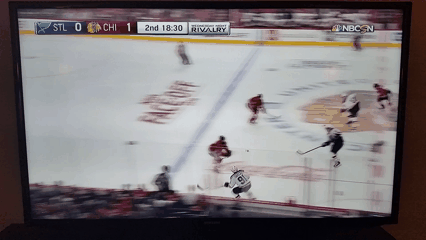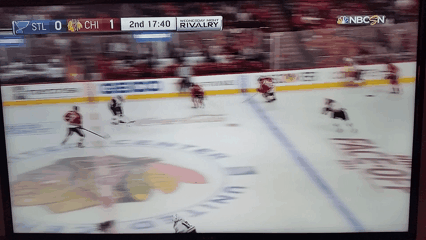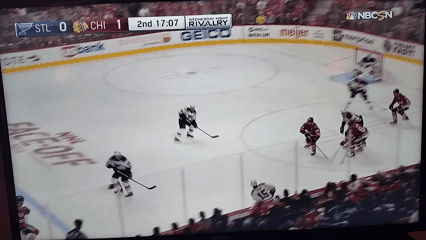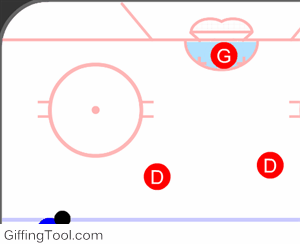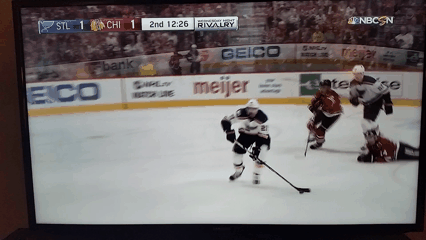![]() I’m going to try something a little different this season, hopefully it becomes a regular feature, but I’m not sure about frequency.
I’m going to try something a little different this season, hopefully it becomes a regular feature, but I’m not sure about frequency.
I love the expansion of system work being performed in the hockey universe and feel that this is an important aspect of team/player evaluation.
There’s a range of twitter follows that do a great job here:
Prashanth Iyer (Detroit)
Mike Darnay & Jesse Marshall (Penguins)
Jack Han (#1minutetactics)
Dave Shapiro (Rangers)
Charlie O’Connor (Philadelphia)
And plenty of others that I have missed.
I’d like to take this into a different direction. Everyone’s read Hockey Plays and Strategies and finding use in spotting trends. I’d like this space to be more about ‘breaking’ the system and offering ideas on how to do that with a certain play, or team scenario, or even make up a play that may fit a particular situation.
The main theme is breaking the system, which every video coach and data analyst should eventually be doing under a team umbrella.
First up, the St. Louis Blues offensive zone entry.
**************
Sometime over the second half of 2015-16, glossing over some data from the Passing Project in the search of identifying rush opportunities, the Blues popped up. Before season’s end, with some video review, the outside/inside approach to the Blues zone entries is fairly evident.
They attack from the outside, stretching the defense to open a shooting lane, exploiting open space. This wide angle approach is regular, looking for outside lanes to penetrate the zone, with a support trailer following up in the same lane – allowing for a retreat to a ‘safe’ transition option should the play fizzle before it’s created.
We are going to mash some data and video to illustrate this strategy, with the question being, can the passing project provide a window into offensive zone strategy.
Project founder, Ryan Stimson attempted to do just that with this Tacalytics piece highlighting offensive strategy.
Ryan Stimson and his passing crew amass data for three passes prior to a shooting attempt (on goal, missed or blocked – denoted here as a ‘non-shot’ on goal). Adding dimension is shot event origin s(coring chance home plate area or outside, as well as spatially from all three zones, including direction (left, right or from the center). I would highly recommend getting familiar with this project, because I’ll be referring to it often. If you want to help track games, get in touch with Ryan.
For my purposes here, we are looking to isolate passes that Stimson has labelled ‘shot assists’ – the last pass before a shot event:
- Originated from the offensive zone on either the right or left side (not off a faceoff)
- Pass was made into the scoring chance area or outside
- A shot event (shot, goal or just an attempt) from the home plate scoring area
The Blues are among NHL leaders in plays originating from the outside and culminating in a shot from the scoring chance area.
The Blues had 20 games recorded. The average number of games tracked is 27 when removing two almost complete Chicago and New Jersey that slightly skew results (raises average to 30)
League wide norms at 5v5, area in the table below, with cumulative number of passes fired from the scoring chance area (SC), or non-scoring chance area. The percentage is a differential indicating the percentage of shots from the scoring area (SC divided by (SC+NSC).
| NHL | SC | NSC | tot | %age of SC shots |
| Shot Attempts | 4552 | 9757 | 14309 | 31.8 |
| SOG | 2448 | 3800 | 6248 | 39.2 |
| Non-SOG | 2104 | 5957 | 8061 | 26.1 |
Isolating St. Louis, produced the results below, with their ranking in each category.
| All | Rk | SC | NSC | tot | %age |
| Shot Attempts | 1st | 136 | 199 | 335 | 41 |
| SOG | 3rd | 73 | 88 | 161 | 45 |
| Non-SOG | 2nd | 63 | 111 | 174 | 36 |
We are primarily interested with the Blues zone entry, but when they do get into the zone without a play into the middle, extended zone time is either below the goal line, or up the wall, to the outside.
Noting that positional fluidity manifests in the attack, when filtering only for forwards we see an NHL leading pattern.
| Fwds Only | Rk | %age | Lg Avg | St Dev |
| Shot Attempts | 1st | 43.32 | 32.19 | 3.66 |
| SOG | 2nd | 47.11 | 39.06 | 4.45 |
| Non-SOG | 1st | 39.68 | 26.39 | 4.79 |
Lets go to video from 2016-17 – as coaching staff has said they’ve implemented changes to their systems.
In this first video, the key piece is the trailer. Vladimir Tarasenko streaks in off the left wing, with David Perron backing him up in the outside lane. There’s no inside drive or anything preventing the play from moving closer to the middle of the ice until well after the entry.
The trailer is key in this scenario, and it will be the central theme of their zone entry and outside approach.
Even with a clear cut two on one forming, Robby Fabri seems somewhat hesitant to drive to the inside and only veers after the pass comes to him, which by that time is offside.
I’m speculating somewhat here because I don’t know what’s happening in his head, but he doesn’t cross the faceoff dots until he is in the offensive zone and the play’s already been whistled dead at the blueline.
Here is a Blues quick break through the neutral zone, in the middle of the ice, yet Paul Stastny forces a pass through a stick and a nearby defender over to the wing.
The Blues incorporated additional risk (without creating any additional benefit – in fact detracting from potential benefit) in the forced pass almost at dead center ice just to get the puck to the streaking Robby Fabbri on the wing.
Alex Steen did his job pushing back the defense pairing into their own zone, then riding the blueline for the stealth weak side entry.
So, the play is forced up the wing and the weak side winger approaches from an outside angle offering little offensive support other than as a trailer.
What’s missing here?
Zero net drive.
There’s no middle lane drive, it’s all on the outside converging to the crease. The winger makes the play without any support, aside from the high player too high in the zone, or on the weak side.
Instead of making a bee-line to the net, Stastny takes up the familiar support position in the outside lane.
There might benefit into the structure to ensure defensive numbers in case the play breaks down which is the ‘safe’ play, but it’s eating at the potential benefit.
During the playoffs, the most frustrating aspect of the Blues forward game was using the outside lane drive and then setting up a cycle or fighting for pucks in the perimeter, losing a battle and repeating the sequence with a dump in. They met their match against San Jose that took away their high posts in the neutral zone (outside of the zone and outside the dots) and didn’t allow any excessive zone time by using the middle of the ice (inside the zone and inside the dots) that wasn’t as heavily trafficked.
Chicago let them operate on the outside and the Blues did an excellent job at scooping up loose pucks. Dallas, with their mid-ice collapse and ‘protect the house’ mentality in the defensive zone almost fell right into the Blues game plan and fell apart when they finally pressured enough to put the series away.
An ideal play here for the zone entry could have been across to the weak side instead of the forced pass to the left wing with Fabbri and Stastny hitting the middle of the ice for net drive, also forcing both defenders to shift their feet.
Ken Hitchcock architected this method to creating offense. Players cut through the outside to the goal if they can get a step around the defender, or they pull the defenseman over towards the outside creating a lane for the support trailer to either shoot on goal, or take it right to the crease.
The latter option is illustrated below.
*****
Even when a defenseman replaces a forward and joins the rush, the mentality is the same.
Mobile blueliner, Alex Pietrangelo, carries the puck up the middle and passes off to the wing instead of attacking the blueline in the middle. Instead of preserving a dangerous inside drive, he takes the lane support position with a net drive coming from the outside via the weak side winger.
Breaking the System
As an opponent recognizing the discernible pattern, I would advise coaching staff to let the outside puck carrier skate to the outside and only engage fully if:
- puck carrier has passed the facoff dots and hasn’t cut into the net
- backside pressure eliminates the support lane trailer
- defense partner has clear position in the crease
Approaching zone entries:
- instead of cheating into the middle, recognize the pattern and post a little wider along the blueline in anticipation of the outside entry
- if possible with numbers, lineup a forward in between the defense pairing, allowing blueline engage to be supported by a forward
- backside pressure attacks the puck battle in support position to ensure no loose pucks squirt into open areas
Follow Gus Katsaros on Twitter (@Katshockey)
































